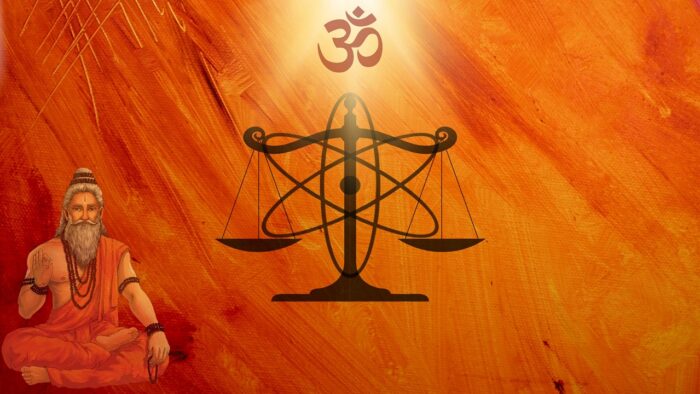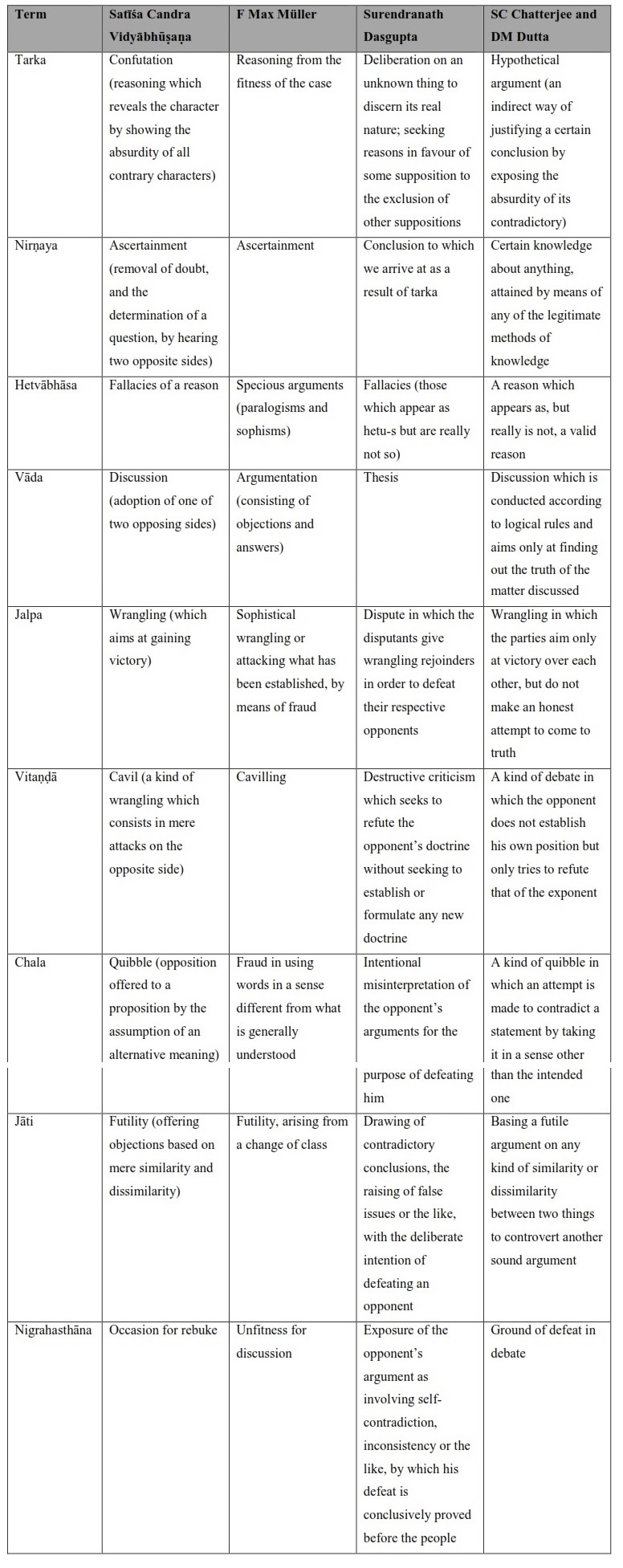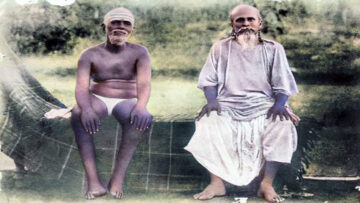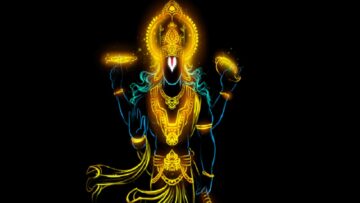Introduction
The Nyāyasūtra (NS) traditionally has the status of being the textual foundation both of Indic epistemology (pramāṇa-śāstra) and Indic dialectics (vāda-vidyā). The formulation of the principles of epistemology and dialectics in early Nyāya texts shows commitment not just towards truthful representation of reality (NS 1.1.1, 1.1.9), but also towards rendering the representation of reality accessible to human beings (NS 1.2.1, 4.2.47-48). For instance, the Nyāyasūtra declaring equivocation during debate as objectionable (NS 1.2.10-18), serves to uphold fairness towards ideas (by protecting against misrepresentation of an interlocutor’s utterances), and also serves the best interest of people (in removing impediments to their apprehension of reality).
The subject of this study is the Nyāyaśāstra ethics of debate, as framed through the Nyāyasūtra characterization of debate malpractice, consisting of the categories of Chala (fraudulent interpretation of terms in a sense different from how they are generally understood), Jāti (futile arguments based on irrelevant and coincidental similarity or dissimilarity) and Nigrahasthāna (grounds of defeat).
The motivation for this examination of the Nyāyaśāstra ethics of debate under the criteria of fairness to ideas and people, is to correspondingly aid the cultivation of both intellectual honesty and altruistic orientation in settings of contemporary discourse including news media and courts of law.
Methods
The Nyāyasūtra portions pertaining to debate malpractice (NS 1.2.4-20, 5.1.1-43, 5.2.1-25) constituted the primary material examined in this study. The Vādanyāya (VN) by the logician Dharmakīrti was parallelly consulted, both for its systematization and critique of the Nyāyasūtra’s Nigrahasthāna-s. Overviews of Nyāya dialectics occurring in academic textbooks on Indian philosophy, were treated as secondary references. The emphasis in this study, rather than on any issue-specific Naiyāyika arguments, was on the debating ethics implicit in the Nyāyasūtra characterization of debating malpractice. Relevance of these Nyāyasūtra characterizations to current judicial processes as well as cases of high public interest, was examined exploratively via a fictional scenario, to identify pointers for future systematic studies.
This article assumes basic familiarity with the fundamentals of Nyāya epistemology as presented in the Nyāyasūtra sections on the means of knowledge or pramāṇa-s (NS 1.1.3-7, NS 2.1.8-54), particularly inference or anumāna along with its standard five-membered process (NS 1.1.32-39) and associated fallacies (NS 1.2.4-9). As an aid to reading the summary presentation of Nyāya dialectics in this article, a table compiling English translations of Nyāya dialectical terms from four different academic textbooks (thus capturing a larger range of traditional connotations of the original term than a single translation would) is provided in the appendix. In this article, the first occurrence of each Nyāyasūtra term is accompanied by a working translation in parentheses and in some instances also by a more extended gloss, and the term is used without translation thereafter.
Review Summary
The frequency with which the dictum “Criticize ideas and not people.” is quoted in popular discourse, suggests that this approach to public debate is prized in contemporary society, regardless of the degree to which it is actually practised. The Nyāyasūtra provides a methodology for criticism of ideas during debate, that is applicable to diverse settings including individual deliberation, discussions between a teacher and student, and debates in more adversarial settings. The diligence demanded by this methodology during its application both in the presence and absence of other people, itself acts as a disciplining influence on criticism of people in all these settings.
Throughout the enumeration of debating malpractices in the Nyāyasūtra, concern is evident for fair consideration of ideas irrespective of whether other people are involved in the deliberation. Application of these principles is understood within the overall soteriological framework of the Nyāya school as also serving the ultimate best interests of people, through facilitating acquisition of right knowledge that causes liberation. The Vādanyāya of the logician Dharmakīrti differs from the Nyāyasūtra in its enumeration of debating malpractices, but is like the Nyāyasūtra in its commitment towards fair consideration of ideas and also the ultimate best interest of people as conceived of in the author’s philosophical school.
The debating checklists in both the Nyāyasūtra and Vādanyāya formulations lend themselves to application to contemporary debates at different levels of formality, from studios of television news channels, to courts of law.
Fairness to ideas
The word “idea” is, for purposes of this article, used to refer to any belief held by a person, regardless of whether it is as yet demonstrated to be true or false by any epistemological standard, and whether it is as yet determined to be desirable or undesirable by any ethical or aesthetic standard. Accordingly, “fairness to an idea” during debate entails that an idea held by a person must be represented distinctly without misattribution and mischaracterization, and protected especially against being mistaken for another idea. Fairness to an idea, when thus upheld, does not necessarily serve the interest of the person holding the idea, either in the limited context of helping secure victory during debate or in broader social contexts by helping improve the person’s reputation or popularity. The elaborate characterization of debate malpractice in the Nyāyasūtra is presented here via a representative sample to demonstrate how it serves fairness to ideas.
Form and content of statements
In Nyāyaśāstra praxis, a statement (that is a step in reasoning or a claim during debate) typically takes the form “An object Ox has a property Pa.”. The classic Nyāyaśāstra example of such a statement is “This hill has fire on it.” In the context of argument, such a claim is expected to be stated with substantiation as follows: “An object Ox has a property Pa, because it has property Pb (that invariably co-occurs with Pa), like another object Oy (which has both the properties Pa and Pb).” The classic example with such accompanying substantiation, is “This hill has fire on it, because it has smoke, like in a kitchen.” In the comprehensive version of the statement, members of the five-membered syllogism can be recognized as follows: (i) Pratijñā (proposition or claim) corresponding to “An object Ox has a property Pa.” and “This hill has fire on it.”.”, (ii) Hetu (reason) corresponding to “because it has property Pb (that invariably co-occurs with Pa)” and “because it has smoke”, and (iii) Udāharaṇa (example) corresponding to “like another object Oy (which has both the properties Pa and Pb)” and “like in a kitchen”.
Raising objections to a statement according to Nyāya principles, demands, at a minimum, that the object and property intended by the speaker are not mistaken for other objects or properties. To the statement “This hill has fire on it.”, suppose that an objector says “But there are underwater hills too!” Such an objection disregards how the object intended by the original speaker is a particular hill on land, and not hills in general, and not all objects that have a hill-like shape. A salient feature of the debate malpractices specified in the Nyāyasūtra is that they amount to misidentifying the object or property or both in the original statement.
Public and private deliberation
The fundamental endeavour of a Naiyāyika, a practitioner of Nyāya, is to arrive at a state of certain knowledge about an object under investigation via legitimate means of knowing (pramāṇa-s), upon consideration of two opposite sides. This process of ascertainment via resolving a binary question of whether or not an object has a certain property, is called Nirṇaya in the Nyāyasūtra (NS 1.1.41). To arrive at Nirṇaya about whether a given object has a given property, requires a process called Tarka (NS 1.1.40) which is initiated by presupposing the presence (or lack) of the property in that object, and examining the consequences for any contradiction. The examination of consequences of the initial presupposition during Tarka is expected to conform to the correct structure of inference, namely, the five-membered syllogism of Nyāya (NS 1.1.32-39) and be free of Hetvābhāsa-s or fallacies of reasoning (NS 1.2.4-9).
The exercise of Tarka to arrive at Nirṇaya can be undertaken ‘in private’ by a solitary individual as well, besides in a public setting involving an opponent. Violations of the correct form of inference, as enumerated via the five types of Hetvābhāsa defined in the Nyāyasūtra, are required to be avoided during an exercise of Tarka regardless of whether this exercise is private or public. Avoiding Hetvābhāsa-s ensures that all any reason presented in support of the proposition legitimately supports that proposition and not its contrary. Specifically, avoiding a Hetvābhāsa of the Savyabhicāra variety (NS 1.2.5) ensures that the reasoning provided for a proposition does not also support the proposition’s contrary, and avoiding a Hetvābhāsa of the Viruddha variety (NS 1.2.6) ensures that the reasoning provided for a proposition does not exclusively assume the proposition’s contrary. This in turn ensures that the distinct identity of each proposition is respected, and that no characteristic not implied in it is attributed to it, thus maintaining “fairness to ideas”. Public debate involving an opponent is classified in the Nyāyasūtra in terms of the participant debater’s intent, and in this process of classification, a comprehensive list of undesirable debating practices, which also subsumes Hetvābhāsa-s, is enumerated.
Varieties of malpractice in public debate
The Nyāyasūtra taxonomy of public debate appears in Chapter 2 of Book 1, where the varieties of defined are Vāda (debate aimed at ascertaining the truth of the matter discussed), Jalpa (debate aimed at securing victory over opponents, indifferent to the truth of the matter being discussed) and Vitaṇḍā (debate aimed merely at refuting the position of the opponent). The practices that lead to debate being characterized as Jalpa according to the Nyāyasūtra (NS 1.2.2) are called “debate malpractices” in this article. These are Chala (attempt to contradict a statement by assuming a meaning of a term different from the intended meaning), Jāti (attempt to controvert a sound argument by a futile argument based on any irrelevant similarity or dissimilarity between things) and Nigrahasthāna (ground of defeat).
The classification of varieties of Chala and Jāti in the Nyāyasūtra is intricate. However, a common feature that can be recognized across varieties, due to which these practices stymie the determination of truth in a debate is as follows: A statement of the form “An object Ox has property Pa.” is distorted by introducing ambiguity in the identity of the object Ox and/or the property Pa, or by outright misidentifying either of them. The overview of debate malpractices of the Nyāyasūtra that follows, does not exhaustively present each variety and is limited to representative examples of how debate malpractices introduce distortions in the attribution of a property to an object and thus obstruct fairness to ideas.
Chala
Three varieties of Chala are defined in the Nyāyasūtra (NS 1.2.10-14), namely, Vākchala (wilfully taking a term in an altogether different sense than the one intended by the speaker), Sāmānyacchala (falsely alleging a true assertion about a particular object in a given class possessing a property, to be a false assertion that every object in that class possesses the property) and Upacāracchala (denying the meaning of a word by taking it literally when it was used metaphorically). When a Vākchala is committed, changing the meaning of the terms identifying the object or the property in a statement like “An object Ox has property Pa.”, can lead to the statement being falsely represented as another statement, like “An object Oy (other than Ox) has property Pa.” or “An object Ox has property Pb (rather than Pa).”. When a Sāmānyacchala is committed, a statement that was originally “An object Ox has property Pa.” is falsely represented as a statement like, “All objects which have a property Pc that object Ox has, have property Pa.”.
Jāti
The entirety of Chapter 1 in Book 5 of the Nyāyasūtra is devoted to naming and defining 24 varieties of Jāti. Of these, some representative varieties serving to illustrate how Jāti obstructs fairness to ideas are presented here. A statement of the form “An object Ox has property Pa.” is misrepresented as “An object Ox has properties Pa and Pd.” (where Pa and Pd have not been established to invariably co-occur) when a variety of Jāti called Utkarṣasamā (assuming an additional property) is committed, and misrepresented as “An object Ox has property Pa and lacks property Pe.” when a variety of Jāti called Apakarṣasamā (assuming lack of another property) is committed. A variety of Jāti called Saṃśayasamā (assuming a definite claim to be an indefinite claim) is committed when a statement of the form “An object Ox has property Pa.” is misrepresented as “An object Ox either has or lacks property Pa.” In the above examples, the properties assumed for an object are not identical to those assumed in the original claim about the object. When the object is treated as similar to another object, on account of sharing the properties thus improperly assumed for it, objections to the original claim based on such similarity are considered inadmissible. Such improper assumption of similarity between objects can occur formally in the Udāharaṇa portion of a syllogism (when a purportedly but not actually similar object is introduced as an example for the original claim featuring another object), or implicitly.
Nigrahasthāna (Nyāyasūtra scheme)
The entirety of Chapter 2 in Book 5 of the Nyāyasūtra is devoted to naming and defining 22 varieties of Nigrahasthāna. Since the listing of Nigrahasthāna-s covers grounds of failure in the context of public debate, it includes not only failures of reasoning (NS 5.2.25), but also failures of articulation (NS 5.2.8-10), failures of adhering to the standard format of argumentation (NS 5.2.11-16), and failures of commitment in defending the stated position on the part of a debater (NS 5.2.17-20, 24). “Fairness to ideas” is served by avoiding the Nigrahasthāna-s specifically pertaining to distortion of the proposition being defended, namely, Pratijñāhāni (advancing an example against the proposition), Pratijñāntara (adding an example inconsistent with the original example offered for a proposition), Pratijñāvirodha (providing a reason contrary to the proposition) and Pratijñāsannyāsa (denying the valid consequences of the proposition). Hetvābhāsa-s are included as Nigrahasthāna-s (NS 5.2.25), and are meant to be avoided as much in public debate as in private exercises of Tarka.
Nigrahasthāna (Vādanyāya scheme)
The Vādanyāya, a text on dialectics by the Buddhist logician Dharmakīrti, is devoted to the examination and simplified reclassification of the Nigrahasthāna-s of the Nyāyasūtra. The Nyāyasūtra’s general concept of a Nigrahasthāna is accepted in the Vādanyāya, but the Nyāyasūtra’s unorganized listing of specific Nigrahasthāna-s is criticized as unsystematic. A more systematic and economical classification proposed in the Vādanyāya groups specific Nigrahasthāna varieties into one of two classes:
- Asādhanāṇgavacana: This refers either to failure on part of the proponent to state/justify a constituent of the proof of the proposition, or including a fallacious/redundant/irrelevant statement in the proof of a proposition. Hetvābhāsa therefore can be grouped under Asādhanāṇgavacana.
- Adoṣodbhāvana: This refers either to failure in pointing out a fault of an opponent, or pointing out a non-fault as a fault. The Nigrahasthāna-s of Paryanuyojyopekṣaṇa (overlooking the censurable) and Niranuyojyāyoga (censuring the non-censurable) named in the Nyāyasūtra (NS 5.2.22-23) can therefore be grouped under Adoṣodbhāvana. The Nigrahasthāna called Apratibhā (lack of ingenuity to come up with a response) in the Nyāyasūtra (NS 5.2.19) can also be grouped under Adoṣodbhāvana.
The Vādanyāya towards its end (VN Section 80) contains a statement that just the two Nigrahasthāna-s of Hetvābhāsa and Apratibhā suffice to cover all conditions during debate that qualify as a Nigrahasthāna, without the need for more intricate classification. While it differs from the Nyāyasūtra classification of specific Nigrahasthāna-s, the Vādanyāya does not deny or diminish the importance of monitoring Nigrahasthāna-s during debate.
Illustration: Essential Religious Practice
Usefulness of the Nyāyasūtra categories of debating malpractice in examining the quality of interventions in a public debate, is illustrated here via example statements and hypothetical reactions to them that correspond to debating malpractices. The example statements, formulated in a fictional scenario, are based on a concept in Indian jurisprudence of simultaneous social, historical and religious significance, namely, the Essential Religious Practice test.
Consider the following fictional scenario. In a town called Nyāyasthāna, there is a temple which since time immemorial allows entry only to those who are able to complete a ritual called Abhyāsapramāṇa involving a series of physical exercises at the entrance. This practice has been criticized in some circles as exclusionary to those unable to perform Abhyāsapramāṇa, and lacking counterparts in any major temple of the same faith elsewhere.
In the above scenario, consider the following propositions and responses to them.
Statement 1: “At the Nyāyasthāna temple, the Abhyāsapramāṇa ritual is a compulsory requirement for entry.”
Reaction: “How can you say that only people who are able to perform a difficult physical exercise can worship at temples?”
This statement can be put in the form “An object Ox has property Pa.” where Ox is “the Nyāyasthāna temple” and Pa is the property of “having the Abhyāsapramāṇa ritual as a compulsory requirement for entry”. The reaction would be appropriate for a statement where the object is “(all) temples”, and is inappropriate for the statement as it is actually stands. If we use Pc to denote the property of “being a temple”, then the reaction is to the statement “All objects which have a property Pc that object Ox has, have property Pa”, which the original statement has been wrongly assumed to be. In short, he object in the original statement is “the Nyāyasthāna temple” and not “(all) temples” like the reaction assumes. Assuming a statement to apply to an entire class when only a particular instance of a class is meant, amounts to the variety of Chala called Sāmanyacchala.
Statement2: “The Abhyāsapramāṇa ritual as a compulsory requirement for entry at the Nyāyasthāna temple is an Essential Religious Practice on account of being followed throughout known history.”
Reaction: “Which important sacred text specifies that this entry requirement is essential?”
The central claim in the statement can be put in the form “An object Ox has a property Pa, because it has property Pb.” where Ox is “Abhyāsapramāṇa ritual as a compulsory requirement for entry at the Nyāyasthāna temple”, Pa is the property of “being an Essential Religious Practice” and Pb is the property of “being presented throughout known history”. The reaction, which has implicit in it the requirement of scriptural mention of a practice, is appropriate not for the current statement, but for a statement of the form “An object Ox has a property Pa, because it has properties Pb and Pt”, where Pt stands for “being mentioned in an important sacred text”. It must be noted here that Pt (property of “being mentioned in an important sacred text”) does not invariably co-occur either with Pb (property of “being followed throughout known history”) or with Pa (property of “being an Essential Religious Practice”).
In short, the original statement claims the status of Essential Religious Practice for the ritual on account of having the property of “being followed throughout known history”. The reaction assumes an additional property of “mention in an important sacred text”, which some other objects (rituals) implicitly assumed to be similar to the original object (Abhyāsapramāṇa) happen to have, but does not invariably co-occur with either of the originally mentioned properties. This amounts to the variety of Jāti called Utkarṣasamā.
This reaction can also be seen as a kind of Chala since the intended meaning of “Essential Religious Practice” in the original statement and the reaction are not the same.
Reactions like in the above examples may appear in settings along a spectrum from informal to formal, spanning drawing-room conversations, television studio debates and court proceedings. Familiarity with the Nyāyasūtra categories of debate malpractice can supply checklists to participants and audiences in all these settings to help recognize and legitimately criticize such reactions.
Fairness to people
A broad working definition of “fairness to a person” for purposes of this article is that a person is said to be treated fairly if the relevant laws (such as a nation’s civil code, or the rules of a sport in which the person is participating) are applied impartially to the person, with an intent to facilitate the person’s best interest in a manner consistent with the letter and spirit of these laws.
In the circumscribed context of formal debate, maintenance of fairness to ideas by protecting them against misrepresentation also aids the maintenance of fairness to all persons participating in the debate. Fairness to people is an underlying concern also in a broader soteriological context, both in the Nyāyasūtra and Vādanyāya.
Fairness during debate
Maintenance of fairness to ideas by protecting the utterances of all participants from misrepresentation, itself amounts to maintaining transactional fairness to persons in the context of debate. A malpractice listed in the Nyāyasūtra that corresponds to a “fair play” consideration in the context of competitive sport, is Vikṣepa (abandoning an ongoing debating match midway citing urgent personal business) which is counted under the Nigrahasthāna-s (NS 5.2.20).
The Nyāyasūtra admits an exception to the prohibition of Chala, Jāti and Nigrahasthāna. These malpractices maybe employed by a Naiyāyika scholar to secure victory in a debate, in which a loss can threaten the faith of students in the very tenets of Nyāya and thus hinder their progress towards salvation as conceived in Nyāya. Occasional expedient use of Chala, Jāti and Nigrahasthāna in the service of more overarching principles than good debating practice, is likened in the Nyāyasūtra to the use of thorny fences to safeguard the growth of seeds (NS 4.2.50). This condition where the Nyāya position accords higher priority to the prospective welfare of people than to strict adherence to rules in one-off cases, can be seen as an instance of fairness to people trumping fairness to ideas in Nyāya.
The Vādanyāya rejects such expedient use of Chala, Jāti and Nigrahasthāna purportedly in the service of eventually establishing truth, and insists that resort to these practices in any form or degree without exception is a disservice to the establishment of truth (VN Section 37).
Fairness beyond debate
Fairness to people, be it in the Nyāyasūtra or the Vādanyāya, is not a concern only in a transactional sense in the context of debate, but also in an ultimate soteriological sense. In the attainment of the soteriological goal of Nyāya called Niśśreyasa (NS 1.1.1), an initial step and proximal goal is the overcoming of suffering or Duḥkha (NS 1.1.2), and the indispensable means is the correct apprehension of reality or Tattvajñāna (NS 1.1.1). Debate in this ultimate context is meant to facilitate correct apprehension of reality, as an activity devoted to arriving at an ascertainment (i.e., Nirṇaya) of the true nature of particular things. Application of the debating principles meticulously propounded in the Nyāyasūtra is thus not an end in itself, but subordinated to the prime imperative of salvation of individuals (NS 1.1.1-2 4.2.50).
In the scheme of the Vādanyāya, the purpose of debate is not the securing of victory but the establishment of truth, for which total adherence to fairness during debate is indispensable (VN Section 37). Fairness during debate, though an indispensable means to the end of establishing truth, is yet a means and not an end. The establishment of truth itself is not an abstract goal, but seen as intimately connected to the welfare of other beings. Welfare of people is identified as the goal of the entire enterprise of formulating the Vādanyāya in the work’s concluding verse (VN Section 93), and it is reasonable to assume that this welfare of people is conceived of as the overcoming of Duḥkha.
Public welfare beyond individual cases
How well the judiciary serves its intended function is reckoned not only via how well it follows due process in individual cases, but also on a systemic scale in how well it serves the public interest by maintaining public trust in the legal process. Noting the principle of “Justice delayed is justice denied.”, maintenance of public trust in the legal process demands reduction of system-wide judicial delays, which are not reducible to how any particular case is dealt with. Decisions on which Public Interest Litigations (PILs) are admitted, eventually have a bearing on judicial delay. Recognizing the Nyāyasūtra’s multi-level emphasis both on transactional fairness and more broadly considered human welfare, can inspire a keener recognition at institutional and societal levels of the public-welfare implications of judicial delays and the need to develop appropriate standards of justification for PILs.
Discussion
In the Nyāyasūtra characterization of debate malpractice, there are no explicit prohibitions of ridicule and invective, of the sort that seems to be found necessary to include in most modern formulations of debating rules. There is no mention also of a designated referee or judge for policing public debates. The conspicuous absence of explicit codification of a decorum and institution of a moderator, suggests that the Nyāyasūtra’s principles of debating are intended for application in a self-regulated setting and assume a level of self-cultivation among participants that obviates aggressive rule-enforcement.
A comprehensive body of recorded use-cases of Nyāyasūtra debating principles invoked in actual historical debates is unavailable, due to the paucity (if not total absence) of complete transcripts of live debates between scholars in antiquity. However, debates in an abstracted, compressed form appear even in the Sūtra texts of philosophical schools. The adhikaraṇa pattern of organization is seen followed in the Mīmāṃsāsūtra and the Vedānta sūtra, where an adhikaraṇa consisting of contiguous sūtra-s includes the statement of rival positions, examination and refutation of rival positions, and a statement of the school’s accepted position. While explicit adhikaraṇa organization is not seen in the Nyāyasūtra, the text does contain instances of a rival position being stated and refuted in a manner free of debate malpractices. Cases in point are the debates on the nature of the connection between words and meanings (NS 2.1.54-57), and on the status of the Veda (NS 2.1.58-69). While the emphasis in this study was on the Nyāyasūtra’s characterization of debating malpractice and not on its positions regarding particular philosophical questions, a topic of future work is an examination of how Nyāya principles of debate are seen applied in the issue-specific debates appearing in the Nyāyasūtra itself.
The basic methodological and ethical framework of dialectics that is assumed in the Nyāyasūtra, is what is also seen adopted with nuanced modification in theVādanyāya. That the Nyāyasūtra and Vādanyāya are respectively products of schools designated asāstika and nāstika, does not negate the fact that they both represent attempts towards systematized expression of a larger Indic dialectical tradition. Assumptions about sui generis Buddhist dialectics radically different from that of orthodox schools like Nyāya, are therefore hindrances to a genuinely synoptic study of traditions of debate in ancient and classical India.
A three-fold need that is traditionally recognized for the correct understanding and application of any discipline, is training in the workings of pada (words), vākya (statements) and pramāṇa (means of knowledge), which are respectively the domain of Vyākaraṇa, Mīmāṃsā and Nyāya respectively. Jurisprudence is no exception to this three-fold need, which is particularly pronounced considering the central role of textual interpretation in law. Current judicial and academic scholarship on application of Mīmāṃsā principles to jurisprudence with an emphasis on the vākya element, can be complemented and augmented by scholarship on the application of Nyāya principles to judicial processes with an emphasis on the pramāṇa element. Even outside of academia, with an increasing trend in availability and circulation of legal judgments of national importance, an aware citizen will benefit from familiarity with tools to critically read them.
Epilogue
The Nyāyasūtra, treated across Indic philosophical schools as a textual foundation of epistemology and dialectics, contains a list of practices to be avoided during debate both in the interest of truth, and in the best interest of all persons concerned. Throughout the Nyāyasūtra characterization of debate malpractice, we can discern a key underlying purpose as the protection of the ideas of each debater against misrepresentation. Nyāyasūtra principles of protecting ideas of all parties from misrepresentation, when applied to contentious contemporary legal questions like “What constitutes an Essential Religious Practice?“, can improve public confidence in the legal process, public order and public understanding.
References
Vidyābhūṣaṇa, S. C. (2018). The Nyāya Sūtras of Gautama (1st ed.). Parimal Publications.
Gokhale, P. P. (1993). Vādanyāya of Dharmakīrti (The Logic of Debate) (1st ed.). Sri Satguru Publications.
Max Müller, F. (1919). The Six Systems of Indian Philosophy (New Impression ed.). Longmans, Green and Co.
Dasgupta, S. (1922). A History of Indian Philosophy (Vol. 1). Cambridge University Press.
Chatterjee, S., & Datta, D. (1948). An Introduction to Indian Philosophy (Vol. 3). Calcutta University Press.
Appendix
Table of English translations of Nyāyasūtra terminology on dialectics
Conference on Ethics Law & Justice
Watch video presentation of the above paper here:
Disclaimer: The opinions expressed in this article belong to the author. Indic Today is neither responsible nor liable for the accuracy, completeness, suitability, or validity of any information in the article.












